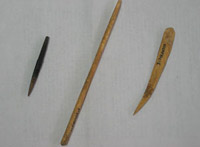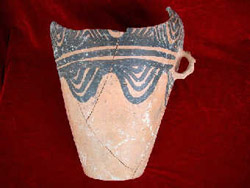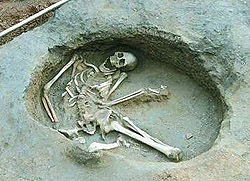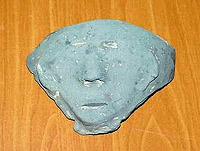Maoxian County lies midway between Chengdu, the capital of Southwest China's Sichuan Province, and Jiuzhaigou, a scenic spot on the United Nations Educational, Scientific and Cultural Organization's World Heritage List, also in Sichuan.
Although an obscure dot on the tourist map, the small county has become a haven for local archaeologists.
After four years of painstaking work, the researchers have brought to light more findings pertaining to the New Stone Age than in any previous excavation in the upper reaches of the Minjiang River, a tributary of the Yangtze River.
The relics unearthed so far offer abundant clues to archaeologists to help them piece together the lives of the prehistorical settlers in the area between 5,500 and 5,000 years ago.
The researchers have named the site the Yingpanshan Ruins, and they are located about 200 kilometers from Chengdu. The site is surrounded with steep slopes on three sides and is near the Minjiang itself.
"The ancient people found it an ideal place to live, as the location made it easier for the inhabitants to safeguard their homeland and to drive away intruding enemies," said Chen Jian, deputy chief of the Second Department of Excavation and Research of the Chengdu Archaeological Team, who is in charge of the excavation.
About 150,000 square meters in extent, the ruins cover the largest piece of fertile, flat land in the upper reaches of the Minjiang.
 The settlers lived by farming. The 10,000 pieces of pottery, jade, stone, bone and objects made from mussel shells unearthed at the ruins have led the researchers to believe that the prehistoric people represent an advanced stage of New Stone Age culture there.
The settlers lived by farming. The 10,000 pieces of pottery, jade, stone, bone and objects made from mussel shells unearthed at the ruins have led the researchers to believe that the prehistoric people represent an advanced stage of New Stone Age culture there.
They were pretty well off, by Stone Age standards, as the tools made of stone, pottery and bone, the colored pottery kettles, and the bottles, cups and bowls indicate a high level of workmanship.
The researchers also unearthed four pottery kiln sites, the oldest and largest pottery kilns found so far in the upper reaches of the Yangtze.
The researchers also found caves which were used for storing grain, which indicates that the local inhabitants had a rich supply of farm produce, Chen said.
Besides farming, the local people also hunted, as they left a large number of stone balls and arrows made of stone and bone at the site, said professor Zhang Zhongpei, former president of the Palace Museum in Beijing.
They also fished, as stone weights to secure fishing nets in the water were also unearthed, Zhang said.
It was only natural for the local people to fish as the Minjiang passes the western, north and northeastern sides of the ruins. The shoals near the ruins were ideal for fishing.
Colored stones and pottery
Stones found in some of the ash pits had been painted with cinnabar, a red, mercury-based powder.
"It is the earliest discovered use of cinnabar in the country," Chen said.
Red paint was found inside a pottery container, as well.
Archaeologists say that the inhabitants of the Yingpanshan Ruins probably worshipped red.
"Their worshipping red had much to do with ancient practice of worshipping the sun and with their own blood, for both are red," Chen said.
 The researchers are especially delighted with the many colored pottery objects they have found, actually the largest number of colored pottery objects found so far in any single site in Sichuan.
The researchers are especially delighted with the many colored pottery objects they have found, actually the largest number of colored pottery objects found so far in any single site in Sichuan.
Most of the pottery objects were thin and made from red soil. To fire pottery objects using this type of red soil, the temperature had to be as high as 1,000 C, Chen said.
Striking any of the pots, one can still hear a clear tone from these 5,000-year-old objects.
The colored pottery objects bear beautiful designs of animals and plants and geometric figures. They were not used merely in people's everyday life but also for sacrificial ceremonies, researchers said.
At the center of the ruins, archaeologists found remains of what they believe to be a square about 200 square meters in extent. Under the square archaeologists discovered four pits containing people who had obviously been buried alive.
It must have been the site where the ancient inhabitants held major communal and ritual activities, Chen said. And they had a brutal custom of killing or burying prisoners of war and slaves alive in sacrificial ceremonies.
The archaeologists have unearthed nine places where they believe the ancient people built their houses. Near the house foundation sites at the center of the ruins are another four burial sites.
The most dramatic finds are the skeletons of a man and woman found in one pit.
The male skeleton shows that the man, whose knees were tied, was struggling with both hands and his mouth opened wide, screaming in pain. The female skeleton shows that the woman was also tied. The difference is that her leg bones had been broken.
Archaeologists speculate that her legs were broken before she was buried alive. This burial custom was adopted as a way to drive away evil spirits and make their houses safe, Chen said.
Linked history
The Yingpanshan Ruins are not the only significant archaeological find in Maoxian County.
Extending their explorations in the area, Chen and his colleagues discovered three other sites that provide additional materials to help fill in the gaps in local prehistory.
Near the Yingpanshan Ruins, Chen and his colleagues also located the 6,000-year-old Boxi Ruins and the 4,500-year-old Shawudu Ruins, both in the upper reaches of the Minjiang River.
 Chen and his colleagues also stumbled upon nearly 60,000 stone coffins by the Yingpanshan Ruins. The stone coffins date back some 2,000 years. Finding such a large number of stone coffins at one time is most unusual, Chen said.
Chen and his colleagues also stumbled upon nearly 60,000 stone coffins by the Yingpanshan Ruins. The stone coffins date back some 2,000 years. Finding such a large number of stone coffins at one time is most unusual, Chen said.
All of the findings have aroused the keen interest of researchers in the Minjiang River valley.
One of the major tributaries of the Yangtze River, the Minjiang connects the eastern rim of the Qinghai-Tibet Plateau and the hinterlands of the Sichuan Basin. With its headwaters in Songpan County in Sichuan, the 745-kilometer-long Minjiang crosses the West Sichuan Plateau, Chengdu Plain and the West Sichuan Basin and flows into the Yangtze River at Yibin in Sichuan.
The area along the upper reaches of the Minjiang was an important corridor for population movement in ancient China.
According to both legends and historical records, ancestors of the Shu people migrated to the Chengdu Plain from the upper reaches of the river. Sichuan was called Shu in ancient times.
The ancient Shu culture is best exemplified by the galaxy of valuable bronzewares found at Sanxingdui Ruins, in Guanghan City, which is only about 40 kilometers from Chengdu.
"There had been almost no excavation of ancient cultural ruins, those dating back to the New Stone Age in particular, in the upper reaches of the Minjiang before," Chen said.
To be able to fill in the gap, Chen and his colleagues started field investigations in the upper reaches of the Minjiang in the Aba Tibetan and Qiang Autonomous Prefectures in June 2000.

Chen claimed that this was the most comprehensive archaeological work ever done in the upper reaches of the river.
The special prize has been the discovery of the Yingpanshan Ruins, Chen said.
The ruins suggest that the ancient inhabitants of the area later moved to the Chengdu Plain, where they created the brilliant Chengdu Plains culture, represented by the Sanxingdui Ruins, for example.
"It takes only one day to walk from the Yingpanshan Ruins on the upper reaches of the Minjiang to Pengzhou, which is in the northwestern part of the Chengdu Plain," Chen said.
(China Daily April 2, 2004)

